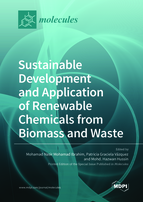Sustainable Development and Application of Renewable Chemicals from Biomass and Waste
A special issue of Molecules (ISSN 1420-3049). This special issue belongs to the section "Applied Chemistry".
Deadline for manuscript submissions: closed (31 October 2022) | Viewed by 29788
Special Issue Editors
Interests: nanomaterials; biomass reutilization; material chemistry; nanocomposite; microbial fuel cells; wastewater treatment
Special Issues, Collections and Topics in MDPI journals
Interests: biowastes; circular economy; green chemistry; catalysis; environmental science; sol-gel technique; functionalized supports
Special Issues, Collections and Topics in MDPI journals
Interests: biomass (particularly lignin, cellulose, hemicellulose) and bioresources process; physical electrochemistry (polarization, impedance, electrochemical noise); corrosion protection (inhibitors and coatings); material technology (polymer electrolytes, absorbent, adhesives, and composites)
Special Issues, Collections and Topics in MDPI journals
Special Issue Information
Dear Colleagues,
Advancements in efficient energy sources have played a pivotal role in determining the present world energy structure. Renewable biomass energy has been incorporated in industrial regulations and policies in many European countries. Based on the statistics, more than one-seventh of the total world energy consumption is generated from biomass.
The renewable energies movement was prompted by two important factors: a) growing world energy consumption and b) the abundance of generated biomass residues, especially in agriculture. In the case of the first, batteries containing different metals are considered, as is the production of items for human consumption (food, clothing, home comfort, etc.). In the second case, the biomass waste from plants and animals, as byproducts of cultivating and production process, is the main source of generated waste.
In agriculture, for example, rice paddies generate rice husks, wheat generates wheat straws, oil palm generates empty fruit bunches, and there are many more related examples. In animal breeding, manure and crustacean shells are some of the byproducts. Consequently, the annual global production of waste, through its considerable increase, has caused serious problems in the soils in which it is present, and its possible conversion and reuse is being explored. Biomass can be used as an alternative material for certain applications due to its carbon-rich structure. In such applications, biomass typically starts by concentrating the carbon in the structure by removing other elements, known as carbonization. Researchers are mainly focused on biomass as activated carbon, due to its cost-effectiveness. Biomass, when converted into a material similar to graphene or graphite, can be used as clean energy in products with added value, such as an electrode in batteries, solar cells, fuel cells, etc.
The waste that is produced by human activities can be used in different technological activities with a sustainable basis. Among them, hygienic paints and fabrics for antimicrobial use have been the object of study for different research groups in recent years.
This Special Issue welcomes full papers, short communications, and review articles highlighting aspects of the current trends in the area of development and application of renewable chemicals from biomass and waste.
Dr. Mohamad Nasir Mohamad Ibrahim
Dr. Patricia Graciela Vázquez
Dr. Mohd Hazwan Hussin
Guest Editors
Manuscript Submission Information
Manuscripts should be submitted online at www.mdpi.com by registering and logging in to this website. Once you are registered, click here to go to the submission form. Manuscripts can be submitted until the deadline. All submissions that pass pre-check are peer-reviewed. Accepted papers will be published continuously in the journal (as soon as accepted) and will be listed together on the special issue website. Research articles, review articles as well as short communications are invited. For planned papers, a title and short abstract (about 100 words) can be sent to the Editorial Office for announcement on this website.
Submitted manuscripts should not have been published previously, nor be under consideration for publication elsewhere (except conference proceedings papers). All manuscripts are thoroughly refereed through a single-blind peer-review process. A guide for authors and other relevant information for submission of manuscripts is available on the Instructions for Authors page. Molecules is an international peer-reviewed open access semimonthly journal published by MDPI.
Please visit the Instructions for Authors page before submitting a manuscript. The Article Processing Charge (APC) for publication in this open access journal is 2700 CHF (Swiss Francs). Submitted papers should be well formatted and use good English. Authors may use MDPI's English editing service prior to publication or during author revisions.
Keywords
- biomass waste reutilization
- applications of lignin
- applications of cellulose and hemicellulose
- energy generation from biomass/waste
- biochemistry of biomass/waste
- hygienic paints
- antimicrobial fabrics









